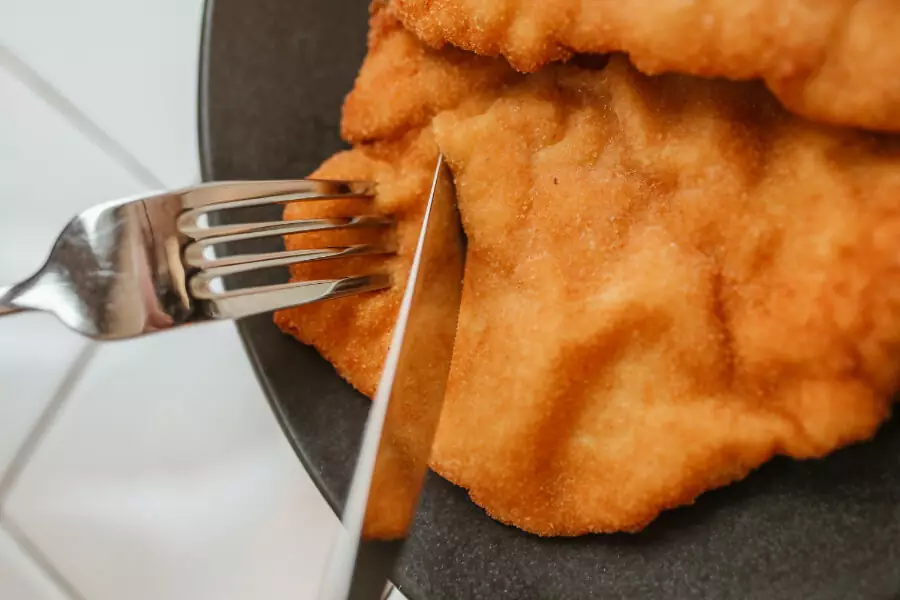A brief history of: the Wiener Schnitzel
Spicy Adventures
Your cart is empty.
SUBTOTAL
£0.00

Spicy Adventures
The Wiener Schnitzel (sometimes the words are joined to form wienerschnitzel) is a favourite of many European nations. In Austria, it’s a national dish – the pride of Vienna. Walk the streets of Berlin and you’ll soon learn that the German’s can’t get enough of them. Of course, they’ll tell you, it’s very important that you don’t confuse this with other schnitzels around the world. This exhaustive list includes:
There are all schnitzels and there are many, many more around the world. But none of them are Wiener Schnitzels, understand? So, what sets the Wiener Schnitzel apart? Well, In Austria they went ahead and trademarked the term ‘Wiener Schnitzel’, protecting it with Austrian laws that mean a dish can only be called a schnitzel if it’s made from veal. A Wiener Schnitzel is made in the same way as any other schnitzel, but the key is that it has to be made using veal. Anything else is a no-go.
The official recipe goes something like this:
With all this being said, it’s pretty difficult to pinpoint exactly where the origins of the Wiener Schnitzel started. While it found its home in Vienna, Austria and enjoys great success throughout Germany and Hungary, they weren’t necessarily the ones to come up with the concept of using veal – that key differentiator.

You see, cross The Alps into Italy and you’ll find something strikingly similar being served up across the northern part of the country. In Milan, they have the ‘Cotoletta alla Milanese’ – the same as the Wiener Schnitzel apart from the fact they cook the veal with the bone still inside.
Meanwhile, in Emilia-Romagna (the foodie heaven of Europe), there’s the ‘Cotoletta alla Bolognese’, named after the city it is found in, Bologna. It is exactly the same as its Milanese counterpart except the addition of some delicious Parmesan cheese and prosciutto.
Naturally, Italy claims to have created the ‘Wiener Schnitzel’ way before Austria. Indeed, there are documents that have been found in the archives of Saint Ambrose, Milan, that reference a Latin name ‘lumbolo cum panitio’. This translates to ‘little chops with breadcrumbs’. Sounds awfully similar to the Cotoletta alla Milanese, no? The Italians certainly think so. These documents are dated to the year 1148AD so, it was clearly around for a while!
In fact, there are historians who argue that it was the Ancient Romans who came up with the dish. Historical finds have shown that they were tenderizing their meat by pounding it, as well as rolling it in breadcrumbs and frying! They found all of this written in the famous cookbook by Apicius, dated to the 1st century. Naturally, the Romans brought this dish north to the Germanic countries during their many war campaigns. Meanwhile, historical data confirms that during the middle ages, veal became a really popular choice of meat in Northern Italy and in the area that is now Austria.
This last piece of information directly contradicts what has long been accepted as the true story of how WienerSchnitzel came to be in Austria. The story went that an Italian General by the name of Joseph Radetzky was reporting to the Emperor of Austria (Franz Joseph I), commenting on the political and military situation in Lombardy at the time. On a tangent, he mentioned a very tasty veal steak. This piqued Franz Joseph’s interest and he personally requested that Radetzky bring the recipe back with him! And so, over The Alps the veal steak recipe went.

Linguists and historians have questioned the exact details of the story over time, but the tale lives on. Certainly, the dish is mentioned in a 1869 Italian gastronomy book, the ‘guida gastronomica d’Italia’ where Radetzky is mentioned and the dish concerned is the Cotoletta alla Milanese. Was he the one to introduce Austria to the schnitzel (and what went on to be termed the Wiener Schnitzel)? Or had this method of cooking been present in Austria for a lot, lot longer? Historians have found clear examples of a breaded schnitzel that appears in a cookbook for Austrian specialities…a whole century earlier than the tale of Radetzky. As mentioned earlier, there were other crumbed meats that were also very popular throughout the country for a long time previous to this event.
If we’re going by the book, then the Wiener Schnitzel’s origins do technically lie in Vienna because of laws and trademarks. The idea of trademarking the ‘Wiener Schnitzel’ name and attributing it to Vienna was born out of an early 20th century movement looking to improve the branding and recognition of Viennese cuisine. By using the name ‘Wiener Schnitzel’ and protecting it, they were able to differentiate the dish from other breaded meats and all the other ways of cooking schnitzels that were found around the world. This was all about branding!
It’s very clear that the schnitzel has been around in one form or another for a lot longer than when the ‘Wiener Schnitzel’ came into being. The Romans (and therefore Italian descendants) can lay claim to its European roots, but who knows where they picked it up from? That’s always the fascinating case about food. It travels far and wide, over time and space. To this day, the schnitzel lives on in many different forms all around the globe.

Understanding Spices
Spices have long been integral to the UK's culinary landscape, adding depth, flavours, and richness to a myriad of dishes. From the pungent aroma of cumin in Indian curries to...
Read MoreUnderstanding Spices
Confetti is an essential part of any wedding day. Not only is it a wonderful way to greet a newlywed couple, but it also provides some beautiful photo opportunities. The...
Read MoreSeasonal Ideas
It’s no secret that any handmade gift will always be more special than a store-bought one. Homemade food gifts are especially wonderful, a labour of love that shows someone you...
Read MoreHealth and Wellbeing
It’s no secret that winter’s cold and gloomy weather makes us crave indulgent dishes like fondue and baked goods like sticky toffee pudding and apple crumble. While Christmas is the...
Read More